Sarah L. Johnson's Blog, page 30
September 30, 2021
V for Victory by Lissa Evans, a darkly comic tale of WWII London
 This darkly comic novel is the third in a loose trilogy, following Crooked Heart (2015) and Old Baggage (2019), and the characters’ backstories are revealed as the plot progresses.
This darkly comic novel is the third in a loose trilogy, following Crooked Heart (2015) and Old Baggage (2019), and the characters’ backstories are revealed as the plot progresses. In 1944, London’s neighborhoods lie battered from attacks by German bombers. Known as an efficient Hampstead landlady, Mrs. Margery Overs is actually an impostor whose real name is Vera (Vee) Sedge, and her 14-year-old “nephew,” Noel, is a former child evacuee she has taken in.
A charmingly sharp lad, Noel cooks for Vee’s lodgers, who tutor him in various subjects. After Vee witnesses a traffic accident, and Noel meets someone who knew his beloved late godmother, their true identities are at risk of being exposed.
Evans excels at portraying war-weary Londoners conducting their lives while death arrives with terrible randomness; among them is air-raid warden Winnie Crowther, whose husband is a prisoner of war. Many are forced to weigh the cost of keeping secrets. The eclectic characters are all uniquely human, and their interactions—there are no dull conversations—make the novel witty and moving.
V for Victory was published by Harper in May in the US, and I'd reviewed it for the April 15 issue of Booklist. I hadn't read the previous two books, but that proved not to be a problem.
Crooked Heart won the ALA's Reading List Award in the historical fiction category in 2016. It tells the story of how Noel ended up living with Vee, and how they become small-time criminals during the Blitz. Old Baggage, set in the late '20s, is the tale of Noel's unofficial godmother, Mattie Simpkin, "a woman with a thrilling past and a chafingly uneventful present" (per the publisher's blurb), a former militant suffragette figuring out what to do with her life now that the vote has been won. Judging by V for Victory, Evans mingles dark humor and serious subjects very well, and her older books promise a similar experience.
Published on September 30, 2021 07:26
September 26, 2021
Messages in the Air: The Watch House by Bernie McGill, set on Rathlin Island in the late 19th century
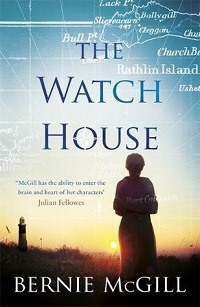 The enduring struggle between ancient traditions and modern technology is given a Northern Irish flair in Bernie McGill’s The Watch House.
The enduring struggle between ancient traditions and modern technology is given a Northern Irish flair in Bernie McGill’s The Watch House. The setting is Rathlin Island, a rugged, picturesque isle just seven miles from the town of Ballycastle on the mainland. Not having heard of it before, I was glad for the opportunity to learn more about the place and its people through historical fiction.
In 1898, as thirty-year-old Nuala Byrne agrees to wed Ned McQuaid, a tailor nearly twice her age, two foreign engineers arrive on Rathlin to test the capabilities of Guglielmo Marconi’s newest marvel – wireless telegraphy. These subplots quickly intersect.
Just a child when her parents and siblings left for a supposedly better life in Canada, Nuala had cared for her aging grandparents until their deaths and hopes for a stable life with her new husband. She doesn’t realize the Tailor and his crabby sister, Ginny, come as a package deal, or that Ginny will treat her as a drudge. Asked to prepare lunches for Marconi’s associates, she develops a rapport with one of them, Gabriel, who teaches her Morse code – and more.
One can guess how their relationship will develop. The novel opens in April 1899 with a scene of Nuala recovering from childbirth, and Ginny planning to take drastic measures to save her brother from raising an illegitimate child. Her traumatic actions almost put me off the rest of the book, but I kept reading and am glad I did.
This evocative novel centers on the mysteries of communication. Introducing Nuala to the notion of electromagnetic waves using layman’s terms, Gabriel, in the island’s watch house, demonstrates how the technological gadgetry can be made to ring a bell. The concept amazes her: “I shake my head and stare at the empty space between the table and a bell. He is asking me to believe in the invisible…
Likewise, Nuala switches easily between Gaelic and English, though never saw herself as a translator before. Plus, there’s a dark-haired girl at the Tailor’s home that no one but Nuala can see. Maybe Nuala is tuned into a special frequency that lets the dead communicate with her, but she isn’t comfortable talking to anyone about it.
The islanders’ dialogue, and Nuala’s lilting narrative voice, complements the small-town Irish locale, and the ending is both satisfying and unsettling. One character’s impressions of Nuala are so different from the quick-minded, brave woman we’ve come to know that it startles. Some communication gaps just seem too deep to bridge.
The Watch House was published in 2018 by Tinder Press in the UK. I've been making a point to read and review more of my own books, even if I've had them for a while, and this is one of them.
 Rathlin Island Harbour
Rathlin Island HarbourCredit: Brian O'Neill, CC BY-SA 3.0, via Wikimedia Commons
Published on September 26, 2021 14:51
September 22, 2021
Review of The Bombay Prince by Sujata Massey, a mystery of 1920s India
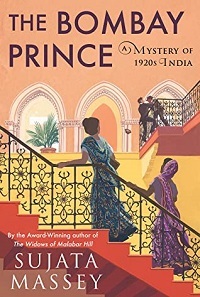 The “Bombay prince” is the future Edward VIII, who in November 1921 took a four-month tour of India, one of the many colonial lands he expected to rule one day. Many Indians supporting independence were angry about the visit, which led to calls for boycotts and agitation in the streets.
The “Bombay prince” is the future Edward VIII, who in November 1921 took a four-month tour of India, one of the many colonial lands he expected to rule one day. Many Indians supporting independence were angry about the visit, which led to calls for boycotts and agitation in the streets. This historic event is the setting for the third in Sujata Massey’s excellent mysteries of 1920s India featuring Perveen Mistry, the country’s first female solicitor (she’s fictional but based on a real-life figure).
Miss Freny Cuttingmaster, a talented student at Woodburn College, stops by Mistry Law for a legal consultation with Perveen. She and her classmates are required to attend the parade celebrating the Prince of Wales’s arrival in Bombay, but Freny detests what he symbolizes and wants to stay away. Impressed by her principles, Perveen advises her as best she can. Then, on the day of the procession, poor Freny’s body is found on the ground, beneath a balcony on her campus. Was her death suicide-as-protest, a political murder, or something else?
Massey admirably directs a cast of dozens, all with distinct personalities and with a range of religious backgrounds. The amount of cultural information smoothly woven through these pages is astounding and is exhibited via the characters’ interactions. The Cuttingmasters are Parsis, like Perveen, which leads her and her lawyer father, Jamshedji, to advocate for Freny’s distraught parents during the coroner’s inquest and ensure her funeral at Doongerwadi isn’t improperly delayed. Feeling an affinity for their late daughter, Perveen wants to see justice done, but she’s disconcerted by Mr. Cuttingmaster’s abruptness (he’s a tailor, as his name suggests) and tries to act without causing offense. She doesn’t always succeed.
Perveen’s manner feels stiff at times, which she acknowledges; it feels appropriate to her status as a pioneering woman in her field who happens to be separated from an abusive husband. Both on the job and within society, her behavior must be above reproach, plus Jamshedji disapproves of her socializing with men. This includes Colin Sandringham, an English political agent helping to arrange the prince’s itinerary. Readers of the previous book will be happy to see him again. Perveen and Colin had become close during her trip to Satapur, but as for a relationship between them – there be danger ahead, she knows.
Followers of the series should delight in how this book ends, and anyone tempted by mentions of the delicious Indian dishes consumed by the characters can find recipes on the author’s website.
The Bombay Prince was published by Soho in 2021; thanks to the publisher for approving me on NetGalley.
Published on September 22, 2021 17:12
September 20, 2021
My notebook and I got drenched and my story was born: an essay by Joanna FitzPatrick, author of The Artist Colony
Joanna FitzPatrick, whose latest novel The Artist Colony is published this month by She Writes Press, is here today with an essay about the research which inspired her fiction.
~
"My notebook and I got drenched and my story was born"Joanna FitzPatrick
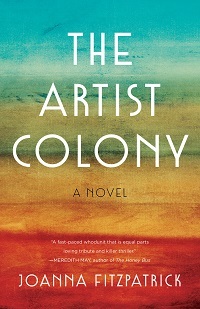 For me, born to travel, research takes me on a journey into the past, and that's why I love writing historical fiction. And it's a journey packed with surprises. Final destination unknown.
For me, born to travel, research takes me on a journey into the past, and that's why I love writing historical fiction. And it's a journey packed with surprises. Final destination unknown.
After writing an historical novel based on the letters and journals of the short story writer, Katherine Mansfield, which required a strict adherence to her biographical point of view, I looked forward to wandering freely into my next historical novel, creating new characters, and this time I wanted to write a mystery.
After you find an era that appeals to you, mine is the 1920s, one of the joys of research is intentionally falling down rabbit holes to find out everything you can about your subject: Prohibition, women's voting rights, rum runners, suffragettes, artists and artist colonies are some of my favorite subjects. And I feel a tremendous responsibility to my readers to thoroughly know these historical facts before I build a story around them.
As you can tell, I love reading history, but as a fiction writer the real exhilaration comes when I resuscitate history through the characters I create and then let them loose to see how they will behave.
One pathway in my research led me to the history of Asian communities in Monterey. The more I read about how these migrants were punished for their self-reliance and determination to make a good life for themselves in America, I knew my historical novel wouldn't be complete without including their powerful, but tragic voices.
In my research into the Portuguese whalers' and immigrant fishermen's stories, I was particularly intrigued by the Japanese abalone divers, which led me to the amas, women divers who also became characters in my novel.
Once I had embedded myself in Monterey's history, it was time to close those weighty books and head out to where that history took place.
As I entered the creaky wooden door into Whalers Cabin at Point Lobos, I felt my story take hold of me. Whalers Cabin was originally built in the mid-1800s and is currently a historical museum with artifacts and photographs of the many people who came to Monterey from long distances and settled on these shores.
Later, standing outside under the canopy of an ancient cypress, I thought, what if . . . and my plot began to percolate. My imagination on fire, pencil in hand, my fingers wrote down my ideas as quickly as I came up with them.
In my own cloud, I wasn't aware of the approaching storm until the heavy clouds burst overhead. It was my first shoreline squall and its dramatic energy added to my own excitement. While my notebook and I got drenched, my story was born.
When the sun broke through and the rain stopped as quickly as it had started, I took the trail outside Whalers Cabin to the unmarked Kodani Village. Gennosuke Kodani, a Japanese abalone diver, made his home on a bluff above Whalers Cove and he caught and canned abalone for a lucrative international market. His Pacific Grove Cannery was built on the opposite side of his village. There are no remnants left of the Kodani Village. But there are sepia photographs of his home, guest houses, bunk rooms, and Japanese women drying abalone on racks. It was easy to put my character Sarah on the bluff watching the women work and smelling the stinky abalones.
Reading history is not always a delicious piece of cake. Historical facts can be heartbreaking when doors open into the past where dark forces are released. In my research, horrible facts were exposed that rattled my strong belief in justice for all. These facts could not be ignored. My characters would have to work through the rampant racism in their own community–to ignore these facts would be a different story.
I went back to the drawing board and expanded my research to our country's treatment of Asian immigrants during the early 20th century so I could better understand the blatant discrimination in this idyllic artist colony on the Pacific shore. These facts would force my characters to question their own humanity. And because of this expanded research, what started out as a plot-driven mystery became a character-driven historical novel with an element of mystery.
I had started The Artist Colony journey before the COVID-19 pandemic, but as I was working on the last revisions, events took place outside my writing studio that linked my hundred-year-old story to the racial discrimination happening today.
I know I don't have the power to change the course of history, but perhaps the readers of The Artist Colony might choose to question their own humanity so that a writer a hundred years from now won't be telling the same story I wrote, because it's true: Those who don't know history are destined to repeat it.
~
 Joanna FitzPatrick
Joanna FitzPatrick
(credit: Michelle Magdalena)Joanna FitzPatrick was raised in Hollywood. She started her writing habit by applying her orange fountain pen and a wild imagination to screenplays, which led her early on to produce the film White Lilacs and Pink Champagne. Accepted at Sarah Lawrence College, she wrote her MFA thesis Sha La La: Live for Today about her life as a rock ’n’ roll star’s wife. Her more recent work includes two novels, Katherine Mansfield, Bronze Winner of the 2021 Independent Publisher Book Award (IPPY) in Historical Fiction, and The Drummer’s Widow. The Artist Colony is her third book. Presently, FitzPatrick divides her time between a cottage by the sea in Pacific Grove, California and a hameau in rural southern France where she begins all her book projects. Find her online here:
Author website: www.joannafitzpatrick.com
Facebook: www.facebook.com/JoannaFitzPatrickauthor
Twitter: https://twitter.com/Fitzpatrick_jo
Instagram: https://www.instagram.com/joannafitzpatrick.author/
~
"My notebook and I got drenched and my story was born"Joanna FitzPatrick
 For me, born to travel, research takes me on a journey into the past, and that's why I love writing historical fiction. And it's a journey packed with surprises. Final destination unknown.
For me, born to travel, research takes me on a journey into the past, and that's why I love writing historical fiction. And it's a journey packed with surprises. Final destination unknown. After writing an historical novel based on the letters and journals of the short story writer, Katherine Mansfield, which required a strict adherence to her biographical point of view, I looked forward to wandering freely into my next historical novel, creating new characters, and this time I wanted to write a mystery.
After you find an era that appeals to you, mine is the 1920s, one of the joys of research is intentionally falling down rabbit holes to find out everything you can about your subject: Prohibition, women's voting rights, rum runners, suffragettes, artists and artist colonies are some of my favorite subjects. And I feel a tremendous responsibility to my readers to thoroughly know these historical facts before I build a story around them.
As you can tell, I love reading history, but as a fiction writer the real exhilaration comes when I resuscitate history through the characters I create and then let them loose to see how they will behave.
One pathway in my research led me to the history of Asian communities in Monterey. The more I read about how these migrants were punished for their self-reliance and determination to make a good life for themselves in America, I knew my historical novel wouldn't be complete without including their powerful, but tragic voices.
In my research into the Portuguese whalers' and immigrant fishermen's stories, I was particularly intrigued by the Japanese abalone divers, which led me to the amas, women divers who also became characters in my novel.
Once I had embedded myself in Monterey's history, it was time to close those weighty books and head out to where that history took place.
As I entered the creaky wooden door into Whalers Cabin at Point Lobos, I felt my story take hold of me. Whalers Cabin was originally built in the mid-1800s and is currently a historical museum with artifacts and photographs of the many people who came to Monterey from long distances and settled on these shores.
Later, standing outside under the canopy of an ancient cypress, I thought, what if . . . and my plot began to percolate. My imagination on fire, pencil in hand, my fingers wrote down my ideas as quickly as I came up with them.
In my own cloud, I wasn't aware of the approaching storm until the heavy clouds burst overhead. It was my first shoreline squall and its dramatic energy added to my own excitement. While my notebook and I got drenched, my story was born.
When the sun broke through and the rain stopped as quickly as it had started, I took the trail outside Whalers Cabin to the unmarked Kodani Village. Gennosuke Kodani, a Japanese abalone diver, made his home on a bluff above Whalers Cove and he caught and canned abalone for a lucrative international market. His Pacific Grove Cannery was built on the opposite side of his village. There are no remnants left of the Kodani Village. But there are sepia photographs of his home, guest houses, bunk rooms, and Japanese women drying abalone on racks. It was easy to put my character Sarah on the bluff watching the women work and smelling the stinky abalones.
Reading history is not always a delicious piece of cake. Historical facts can be heartbreaking when doors open into the past where dark forces are released. In my research, horrible facts were exposed that rattled my strong belief in justice for all. These facts could not be ignored. My characters would have to work through the rampant racism in their own community–to ignore these facts would be a different story.
I went back to the drawing board and expanded my research to our country's treatment of Asian immigrants during the early 20th century so I could better understand the blatant discrimination in this idyllic artist colony on the Pacific shore. These facts would force my characters to question their own humanity. And because of this expanded research, what started out as a plot-driven mystery became a character-driven historical novel with an element of mystery.
I had started The Artist Colony journey before the COVID-19 pandemic, but as I was working on the last revisions, events took place outside my writing studio that linked my hundred-year-old story to the racial discrimination happening today.
I know I don't have the power to change the course of history, but perhaps the readers of The Artist Colony might choose to question their own humanity so that a writer a hundred years from now won't be telling the same story I wrote, because it's true: Those who don't know history are destined to repeat it.
~
 Joanna FitzPatrick
Joanna FitzPatrick(credit: Michelle Magdalena)Joanna FitzPatrick was raised in Hollywood. She started her writing habit by applying her orange fountain pen and a wild imagination to screenplays, which led her early on to produce the film White Lilacs and Pink Champagne. Accepted at Sarah Lawrence College, she wrote her MFA thesis Sha La La: Live for Today about her life as a rock ’n’ roll star’s wife. Her more recent work includes two novels, Katherine Mansfield, Bronze Winner of the 2021 Independent Publisher Book Award (IPPY) in Historical Fiction, and The Drummer’s Widow. The Artist Colony is her third book. Presently, FitzPatrick divides her time between a cottage by the sea in Pacific Grove, California and a hameau in rural southern France where she begins all her book projects. Find her online here:
Author website: www.joannafitzpatrick.com
Facebook: www.facebook.com/JoannaFitzPatrickauthor
Twitter: https://twitter.com/Fitzpatrick_jo
Instagram: https://www.instagram.com/joannafitzpatrick.author/
Published on September 20, 2021 06:00
September 16, 2021
The Floating Book by Michelle Lovric, a sensual novel of 1460s Venice
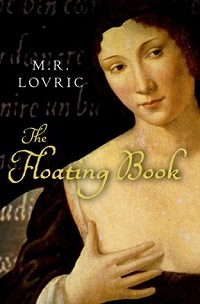 Set mostly in 1460s Venice, the atmosphere of M. R. Lovric’s The Floating Book resembles dark chocolate: alluring, richly decadent, and somewhat bittersweet.
Set mostly in 1460s Venice, the atmosphere of M. R. Lovric’s The Floating Book resembles dark chocolate: alluring, richly decadent, and somewhat bittersweet. The novel is an older title which I’d bought just after its publication but hadn’t read until now – my bad. The copy on my shelves is the Virago (UK) edition, from 2003 (with the gorgeous painting at left), but it was also published in the US under the author’s full name, Michelle Lovric (below at right). The Goodreads reviews are all over the place: some readers adored it, while others couldn’t finish. I decided to ignore the critics and dive in, and I’m glad I did.
The story follows a collection of intriguing characters as their lives become entangled. Sosia Simeon, a troubled young Jewish woman from Dalmatia, has a series of sexual liaisons with men – she prefers Venetians – while ignoring the older husband she detests, a caring Jewish doctor. Wendelin von Speyer arrives from Germany with his brother, Johann, and they secure a monopoly on the newfangled, controversial trade of mechanical printing. Several men grow obsessed with Sosia, including Wendelin’s editor Bruno Uguccione (she becomes his first lover), while there’s one who doesn’t, to her dismay: the scribe Felice Feliciano.
In Italian, we learn, the word sosia means a lookalike, a theme Lovric skillfully plays with. The woman Sosia becomes the dark reflection of another character: Wendelin’s bright-haired Venetian bride, Lussièta, whose first-person narrative enters the story partway through. Their marriage, blissful at first, grows progressively more strained. Wendelin’s decision to publish the work of the Latin poet Catullus, whose frank eroticism shocked the ancient Romans and Renaissance-era Venetians alike, seems to shadow all the characters like a dark cloud. Letters from Catullus himself, in unrequited love with the scandalous Roman noblewoman Clodia, add interesting parallels, since Clodia and Sosia have much in common.
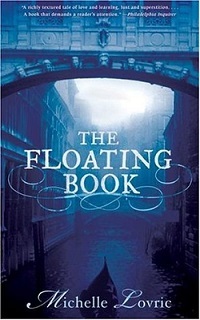
What hits you first is the language, which reads like poetry:
“In certain light-suffused mists, Venice deconstructs herself. One sees faint smears of silhouettes, and in these the architect's early sketches: the skeletons of the palazzi as he saw them on paper when they were only dreams. When the haze lifts, those buildings swell again with substance, as if freshly built. But until that happens the Venetians nose their way around their city…”
The Floating Book has as many moods as Venice herself: by turns romantic, industrious, seductive, joyous, and sinister. Lovric gives us many funny moments by introducing Wendelin’s thieving cat and a letter from Wendelin to his former mentor at home, in which he despairs of his patrons’ and employees’ involvement with unsuitable women, not realizing they all are Sosia. We also have a multi-page rant by a Venetian priest against the ungodly book, which is both hilarious in its over-the-top pomposity, and frightening in its fanaticism.
I confess I found the last part of the novel the least compelling, since the darkness that befalls nearly everyone doesn’t always make sense, other than it’s a plot direction the author wanted to take. In other ways, though, the mysteriousness of the Venetian setting adds to its fascination. Even with so many facets of the city brilliantly illustrated, some aspects remain filmy and tantalizingly unknowable.
Published on September 16, 2021 16:40
September 13, 2021
Early Hollywood is a family affair in The Limits of Limelight by Margaret Porter
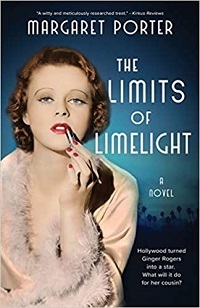 Margaret Porter’s newest historical novel introduces the early life of Helen Brown Nichols, a teenager from Oklahoma City whose family connections led her to modest success as an actress during the Depression – but who found enduring professional achievement in a different artistic field.
Margaret Porter’s newest historical novel introduces the early life of Helen Brown Nichols, a teenager from Oklahoma City whose family connections led her to modest success as an actress during the Depression – but who found enduring professional achievement in a different artistic field. Helen’s Aunt Lela and her first cousin, Virginia “Ginger” Rogers, see potential in the dark-haired beauty, and it doesn’t take much convincing for Helen to accept their invitation to live with them in Hollywood, the idea being that the pair will look out for her while helping open doors to opportunities. Before Helen even arrives in the big city, Ginger persuades her to take the stage name “Phyllis Fraser,” and Porter refers to her as Phyllis from that point forward.
The tale moves with a light, steady pace as it nimbly illustrates Phyllis’s professional successes and disappointments, including her securing a contract with RKO and her hopes to appear on-screen beyond all-too-brief appearances (some of her initial performances end up on the cutting-room floor).
In a competitive atmosphere notorious for overlarge egos and backstabbing, The Limits of Limelight stands out as a story of female friendship and mentorship. Aunt Lela and Ginger steer Phyllis away from casting couches and other pitfalls, and Phyllis’s level-headed nature serves her well, also, even as a minor. Many future screen stars establish a firm presence on the page – Boris Karloff, Katharine Hepburn, Fred Astaire – giving readers a glimpse of their personalities and lives before they became famous.
Phyllis becomes good friends with Peg Entwistle and Mary Blackford, actresses whose lives and careers deserve to be better known. She also grows close to the actress Dawn O’Day/Anne Shirley. Both of these are stage names, a practice that’s treated as nonchalantly as the rest of Hollywood does. Dawn/Anne takes her name from the part she played in Anne of Green Gables, and even her real-life mother adopts the last name of “Shirley” going forward! Although Phyllis does her best, she feels her true talent lies in writing and pursues opportunities as she’s able.
While it may lack the dramatic twists and turns of juicier Hollywood sagas, this shouldn’t be seen as a defect. The Limits of Limelight is solid, well-researched historical fiction providing a behind-the-scenes look at the screen stars who entertained Depression-era America.
The Limits of Limelight is published tomorrow, Sept. 14th, by Gallica Press; thanks to the author for a PDF copy. [Find it on Goodreads]
Published on September 13, 2021 06:30
September 4, 2021
Gayl Jones's Palmares, an immersive epic of seventeenth-century colonial Brazil
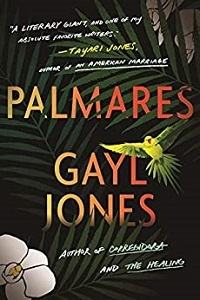 After a 21-year absence, Jones makes a strong return with her mesmerizing epic of late 17th-century Brazil. Her narrator is a Black woman, Almeyda – a name spelled differently than that of a former Portuguese colonial governor (de Almeida), which she tells people who note the similarity.
After a 21-year absence, Jones makes a strong return with her mesmerizing epic of late 17th-century Brazil. Her narrator is a Black woman, Almeyda – a name spelled differently than that of a former Portuguese colonial governor (de Almeida), which she tells people who note the similarity. Educated by a priest on the plantation where she is enslaved as a child, Almeyda soaks up stories and keenly observes everything. Following many significant and traumatic life changes, she flees to Palmares, a legendary community promising liberty for the enslaved, and marries her husband there. After Palmares is demolished, Almeyda travels widely to find him, hoping he survived.
Jones’s storytelling exerts a powerful pull, and readers will achieve complete immersion into a setting whose African and Indigenous cultures are memorably delineated. Through richly woven prose, Almeyda’s journey compels reflection on how freedom must always be defended and how women bear extra societal burdens.
The mystical sequences give the plot additional depth and texture. While overly long in parts, Jones’s novel is a superb reclamation of the historical narrative.
Gayl Jones' Palmares will be published by Beacon Press on Sept. 14th; I'd reviewed it from an Edelweiss copy for Booklist's September 1 issue.
Some additional notes:
It's hard to encompass an epic novel of 500 pages in a review of 175 words. There are dozens of characters, with new people introduced in nearly every chapter, which has the potential for confusion. Each is so distinct, however, that they're not difficult to remember, and some make later appearances, too.
Palmares (or the Quilombo dos Palmares, "quilombo" meaning a community of former enslaved people) was a real settlement in eastern Brazil that thrived for most of the 17th century; read more at Black Past. My e-copy of the novel didn't have a map, but I made use of ones I found online as I was reading.
I especially appreciated how Palmares upends the traditional narrative about colonial history by centering the viewpoint of a multilingual Black woman along a personal journey, and by showcasing the cultures, religions, and languages (Portuguese, Tupi-Guarani, English, and more) mingling at this place and time. Almeyda's mother describes their family as "Sudanese with a touch of Moorish blood." Her grandmother also plays a memorable role.
Read more about Gayl Jones' life and literary accomplishments at Publishers Weekly and in The Atlantic ("The best American novelist whose name you may not know"), as profiled by Calvin Baker. Her first editor was Toni Morrison, who championed her work after reading her first manuscript in 1975. Jones wrote, revised, and polished Palmares over the course of more than 40 years, and readers will soon get the opportunity to experience it for themselves. She is reportedly a private person who doesn't do interviews, but you can expect to be hearing more about the book in literary circles after it's published in two weeks.
Published on September 04, 2021 08:00
August 30, 2021
The Perfume Thief by Timothy Schaffert takes an original look at Nazi-occupied Paris
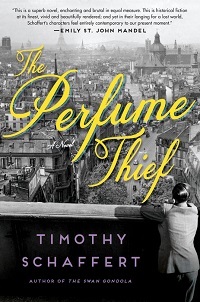 Incorporating the tense setting of Nazi-occupied Paris, Schaffert concocts a memorable work that oozes atmosphere and originality.
Incorporating the tense setting of Nazi-occupied Paris, Schaffert concocts a memorable work that oozes atmosphere and originality. Her criminal past behind her, the stylishly dapper Clementine, a queer American in her early seventies, runs a thriving perfume shop supplying fragrances for the women of the cabarets. Then Zoé St. Angel, the headlining chanteuse at Madame Boulette’s, pleads for Clem’s help in retrieving a diary with the secret formulas used by a missing perfumer, Monsieur Pascal.
Clem accepts this dangerous challenge, which involves keeping company with the Nazi living in Pascal’s house, Oskar Voss, who adores French culture. “Perfume isn’t only about chemistry. It’s also about psychology,” she says, and the novel is redolent with exquisite scents, the meanings they convey, and the memories they evoke.
The plot sometimes gets buried underneath all the descriptions, but it boasts beguiling characters who gain depth with each unveiled layer. Schaffert creates a lasting impression through his tribute to these unique artists – the “alchemists of the city’s very soul” – and their courageous and creatively daring methods of resistance.
The Perfume Thief is published by Doubleday this month. I wrote this review for the July issue of Booklist, based on a NetGalley copy. Even if you're feeling weary of WWII settings, this title is different and well worth reading.
Published on August 30, 2021 17:00
August 25, 2021
My Policeman by Bethan Roberts depicts a complex love triangle in 1950s Brighton
 Roberts’ dramatic novel, first published in the UK in 2012 and now adapted for a forthcoming film starring Harry Styles, Emma Corrin, and David Dawson, poignantly depicts a love triangle that tears apart three lives.
Roberts’ dramatic novel, first published in the UK in 2012 and now adapted for a forthcoming film starring Harry Styles, Emma Corrin, and David Dawson, poignantly depicts a love triangle that tears apart three lives. In 1950s Brighton, England, schoolteacher Marion Taylor has had a longtime crush on her friend’s older brother, the blond, athletic Tom Burgess. They grow close as he gives her swimming lessons, but Marion ignores signs that something is amiss.
To achieve respectability and hide his romantic relationship with museum curator Patrick Hazelwood, Tom, a police constable, marries Marion. Jealousy soon rears its head.
Roberts tells the story through Patrick’s journal and Marion’s confessions, which she pens in 1999 while caring for Patrick following his stroke. Their accounts make for riveting but occasionally uncomfortable reading. Marion doesn’t seem particularly kind, while Patrick endangers himself by writing about his feelings and actions, since being gay was illegal at the time.
Both call Tom “my policeman,” and one senses love and defiant possessiveness in the word my. Scenes of seaside Brighton and the era’s repressive attitudes are skillfully rendered.
My Policeman is published by Penguin this month in the US; I reviewed it for Booklist in July. According to IMDB, the film version is currently in post-production. Read more about the film at Vogue UK.
Published on August 25, 2021 13:41
August 22, 2021
Painting the Light by Sally Cabot Gunning examines women's freedoms on Martha's Vineyard in 1898
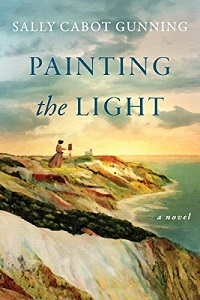 Gunning’s sixth historical novel, set on Martha’s Vineyard in 1898, is a luminous portrait of a woman regaining her independence.
Gunning’s sixth historical novel, set on Martha’s Vineyard in 1898, is a luminous portrait of a woman regaining her independence. Ida Pease wasn’t always a farm wife; she had grown up on Boston’s Beacon Hill and trained as a watercolor artist. After the tragic deaths of everyone in her family, Ida had been charmed by a sheep farmer from Vineyard Haven, Ezra Pease, and chose to marry him – thus giving him access to her money.
Two years later, left in charge of the lambing and harvest while Ezra occupies himself elsewhere, she regrets her hasty decision. When the Portland is wrecked in a storm while sailing to Maine, and Ida learns Ezra and his business partner, Mose Barstow, were aboard, she is stunned but can’t muster up grief for her unpleasant late husband.
Ezra’s death, however, opens a Pandora’s box of secrets, the gradual revelation of which drives the plot along. Ida abruptly finds herself without means and dependent on others for support and answers – among them Ezra’s flinty Aunt Ruth and Henry Barstow, Mose’s brother and executor, to whom Ida has always felt an inexplicable connection.
The pacing is unhurried, but this isn’t a weakness: depictions of the island’s pastoral beauty and the hard work of rural life encourage lingering. The characters have significant depth and multiple rough edges, Ida included.
Eager to return to Boston and resume painting, Ida is forced instead to fight for every inch of emotional ground and every dollar owed to her. She also takes up bicycling – these scenes feel wonderfully freeing – though many island residents find her actions unladylike. The background details on the women’s suffrage movement are a natural fit for this intricate tale of a woman learning to observe the true colors of the world around her.
Painting the Light is out now from William Morrow; I reviewed it from an Edelweiss e-copy for the August issue of Historical Novels Review.
Read also Elisabeth Lenckos's interview with the author at the Historical Novel Society website.
Published on August 22, 2021 06:30



